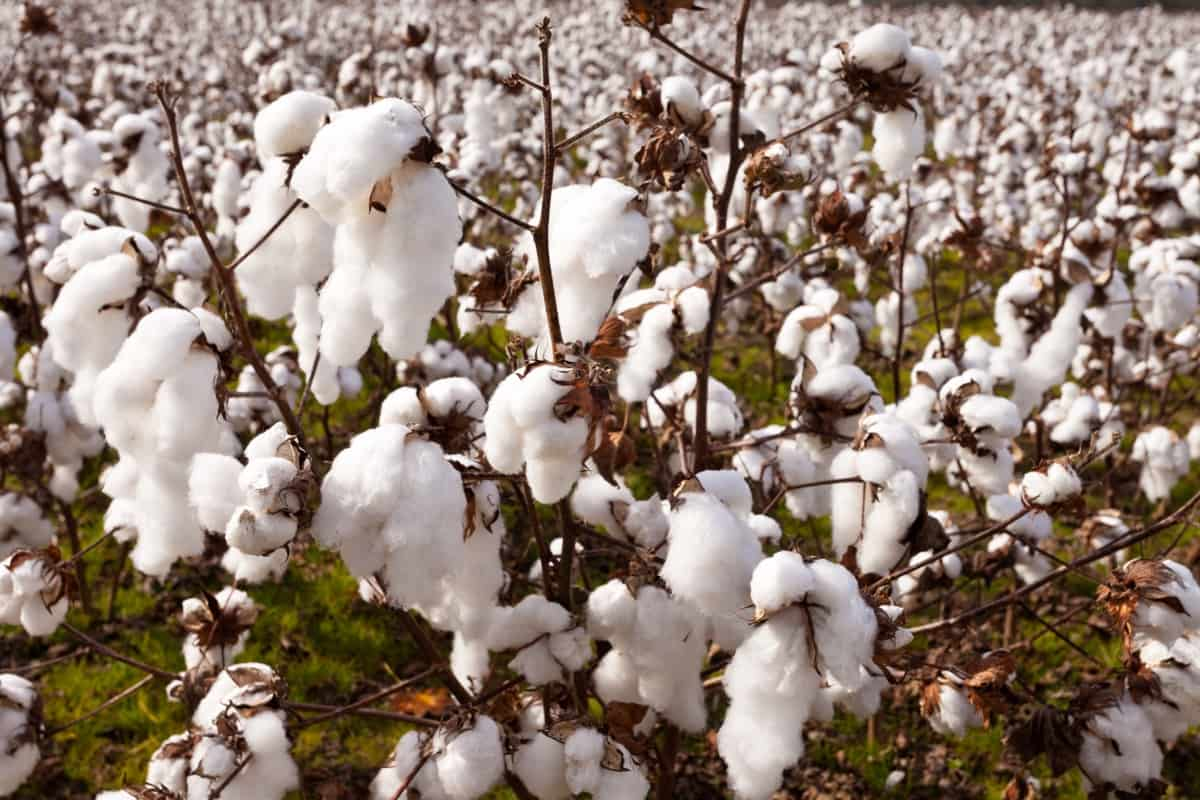Cotton, a Major cash crop in India, is a crucial raw material for the textile industry. However, it faces significant threats from various sucking pests, including Whitefly, Jassid, Mealy bug, and Mites. Whitefly has emerged as a major economic menace, leading to substantial yield losses in agriculture, horticulture, and ornamental crops. This is primarily due to its rapid population growth, mobility, broad diet, and capacity to transmit Cotton Leaf Curl Virus (CLCV) while also causing black sooty mold on leaves.

Introduction to Whitefly Infestation in Cotton Crops
Whitefly infestation in cotton crops presents a pressing issue in agriculture. These tiny insects, characterized by their white appearance, have become a significant concern for cotton growers. They feed on plant sap, causing damage to the cotton plants. Whiteflies reproduce rapidly, leading to population explosions that can devastate cotton yields. Furthermore, they can transmit harmful viruses, such as the Cotton Leaf Curl Virus (CLCV), compounding cotton farmers’ economic losses.
Identifying Symptoms of Whitefly Infestation in Cotton Plants
- Eggs: Whitefly eggs are yellowish-white and typically laid individually on the undersides of leaves. They have stalks and appear sub-elliptical in shape.
- Nymphs: Whitefly nymphs are yellowish and brownish, resembling small scales. They are often found in large numbers on the undersides of leaves, where they feed and develop.
- Pupae: The pupal stage of whiteflies closely resembles nymphs in shape and features brownish opercula, which are protective covers.
- Adults: Adult whiteflies are tiny and white. They possess a yellow body lightly coated with a white waxy powder.
- Females: Female whiteflies are slightly larger, measuring about 1.1–1.2 mm in length. They have longer antennae compared to males.
- Males: Male whiteflies are slightly smaller and distinguishable by their extended, narrow, and pointed parameres.
- Six or more adult whiteflies are present per leaf in the upper canopy of plants, indicating a significant infestation.
- More than ten whiteflies are observed in the middle region of the plant in over 50% (at least two out of four) of the plants.
- When plants are gently shaken, adult whiteflies’ flight produces a smoky appearance, further signifying a substantial population.
Understanding the Life Cycle of White Flies in Cotton Crops
Whitefly infestation poses a formidable challenge to the cotton industry, making it a pressing concern in agriculture. These minuscule insects, easily recognizable by their white coloration, have become a major worry for cotton cultivators. Whiteflies feed on plant sap by piercing the leaves, which weakens the cotton plants and creates opportunities for disease transmission. Their astonishing reproductive rate exacerbates this problem, leading to exponential population growth that can wreak havoc on cotton yields.
In case you missed it: Sucking Mealybugs in Cotton Crop: Symptoms, Causes, Control, and Treatment

The consequences of whitefly infestations extend beyond direct damage. These pests are notorious for their ability to act as vectors for harmful viruses like the Cotton Leaf Curl Virus (CLCV). When they feed on infected plants, they can acquire the virus and transmit it to healthy cotton crops, compounding the economic losses cotton farmers suffer. Therefore, effective strategies for whitefly management are imperative to safeguard cotton production, enhance crop resilience, and secure agricultural sustainability.
Cultural Practices for Whitefly Management in Cotton Fields
- Variety Selection: Choose recommended and early maturing hybrid cotton varieties known for their resistance against whiteflies. Avoid late-maturing varieties, as they are more susceptible to whitefly damage.
- Surveillance on Alternate Hosts: Regularly surveillance alternate host crops such as brinjal, cucurbits, cucumbers, long melon, pumpkin, tomato, chili, and okra starting in February. This proactive monitoring helps in identifying whitefly presence early for timely management.
- Weed Control: Eradicate weed hosts like Parthenium, Kanghi buti (Sida sp.), Peeli buti (Abutilon indicum), Datura metel, Gutputna (Xanthium sp.), Puthkanda, Bhakra, Itsit, and Tandla during the off-season. Removing these weed hosts helps prevent whitefly multiplication.
Biological Control Methods for White Flies in Cotton Crop
- Predatory Insects: Encourage the presence of natural predators such as ladybugs, lacewings, and parasitic wasps. These beneficial insects feed on whitefly nymphs and adults, helping to keep their populations in check.
- Fungal Pathogens: Utilize fungal biopesticides like Beauveria bassiana and Isaria fumosorosea. These fungi infect and kill whiteflies, reducing their numbers.
- Entomopathogenic Nematodes: Apply nematodes like Steinernema feltiae and Heterorhabditis bacteriophora to the soil. These microscopic roundworms parasitize whitefly larvae in the soil, disrupting their life cycle.
- Release of Predatory Beetles: Certain beetles, like Delphastus catalinae, are effective predators of whiteflies. Introducing them into cotton fields can help control whitefly populations.
- Cultural Practices: Implement practices that enhance natural enemy populations, such as reducing broad-spectrum pesticides that harm beneficial insects.
- Resistant Varieties: Select cotton varieties that are less attractive to whiteflies or possess inherent resistance.
Management Practices for Whitefly in Cotton Crop
Pre-sowing Operations
- Opt for recommended and early maturing hybrid cotton varieties resistant to whitefly.
- Avoid late-maturing varieties to minimize whitefly damage.
- Conduct regular surveillance of alternate host crops like brinjal, cucurbits, and cucumbers starting in February to enable timely whitefly management.
- Eliminate alternate weed hosts such as Parthenium, Kanghi buti, Peeli buti, Datura metel, and others during the off-season to prevent whitefly multiplication.
In case you missed it: Pests and Diseases Management in Cotton: Causes, Symptoms, Chemical, and Biological Control

Sowing Operations
- Grow only recommended Bt cotton cultivars.
- Ensure timely sowing between April 1st and May 15th.
- Follow recommended plant spacing and include a line of refusal cotton plants to maintain BT resistance against the Boll Worm complex.
- Avoid intercropping with cucumbers, okra, and other susceptible crops.
- Plants less preferred host crops like maize, bajra, jawar, and dhecha around the cotton field.
- Apply the recommended dose of fertilizers (N, P) based on soil testing.
- Use Muriate of Potash (MoP) at 20 kg per acre to enhance crop stress tolerance.
- Practice judicious and timely irrigation during the vegetative and flowering phases to prevent excessive vegetative growth that favors whitefly buildup.
Vegetative Phase
- Monitor the cotton field regularly from April onwards and take appropriate actions for timely management.
- Pay special attention to surveillance when cotton crops are near Kinnow orchards.
- Apply Potassium nitrate (NPK 13:0:45) at 2 kg/acre at fortnightly intervals, starting from the square initiation stage, to manage flower and boll dropping issues.
- Educate farmers about identifying, conserving, and augmenting natural enemies like parasitoids and predators to suppress whitefly populations.
- Employ low-cost yellow sticky traps at a rate of 40 per acre during the early stages of cotton growth to detect early whitefly infestations.
- Maintain proper weed control for at least 8-9 weeks after sowing through clean cultivation and timely inter-culture.
- Use Azadirachtin-based sprays or homemade neem extracts to combat whiteflies.
- Implement Verticillium lecanii 1.15%WP at 2.5 kg/ha in 500 liters of water against whiteflies.
Reproductive Phase
- Continue regular crop monitoring.
- Avoid synthetic pyrethroids to prevent whitefly resurgence.
- Apply chemical insecticides when whitefly populations exceed the Economic Threshold Level (ETL).
- Use recommended insecticides based on need, considering their effectiveness against whitefly nymphs or adults.
- Practice insecticide group rotation to prevent resistance buildup.
- Adjust the choice of insecticide based on the whitefly population and symptoms.
Chemical Control Options for Whitefly Infestation in Cotton Plants
Chemical control options for whitefly infestations in cotton plants include using neem-based solutions and specific insecticides. Neem-based treatments consist of Azadirachtin 0.15% or Azadirachtin 0.03% (Neem Oil Based) applied at 2.5-5.0 l/ha, as well as Homemade Neem Extract at a rate of 2.5 l/ha to combat whiteflies.
In case you missed it: Best Fertilizer for Cotton: Organic, Compost Manure, Liquid, NPK, and Schedule

When whitefly populations exceed the Economic Threshold Level (ETL), chemical insecticides become necessary. Recommended insecticides for need-based applications include Flonicamid 50WG, Diafenthiuron 50WP, Pyripoxyfen 10EC, Spiromesifen 22.9 SC, Dinotefuran 20SG, Buprofenzin 25SC, Chothianidine 50WG, and Ethion 50EC, each with specific application rates per acre and proper dilution in 200-250 liters of water. It’s advisable to use Flonicamid 50 WG, Diafenthiuron 50WP, Ethion 50EC, or Triazophos 40 EC for severe whitefly infestations at specified rates with appropriate water dilution.
Integrated Pest Management (IPM) Strategies for Whitefly Control in Cotton Crops
These strategies include using resistant cotton varieties, timely sowing, proper spacing, and employing natural predators like ladybugs. Additionally, regular surveillance for whitefly presence and targeted chemical applications when population levels exceed the Economic Threshold Level (ETL) ensures effective control. Cultural practices, such as weed management and crop rotation, play a role in reducing whitefly habitats. The judicious use of neem-based treatments and specific insecticides further aids in managing whitefly infestations, promoting sustainable cotton cultivation.
Importance of Early Detection and Timely Action against White Flies in Cotton Plants
- Variety Selection: Opting for recommended early maturing hybrid cotton varieties resistant to whiteflies (Bt cotton) at the pre-sowing stage is essential. Late-maturing varieties are susceptible to whitefly damage, so they should be avoided.
- Surveillance: Starting from February, regular surveillance of alternate host crops and weed hosts helps identify whitefly presence early. This timely monitoring is critical for effective management.
- Crop Management: During sowing, choosing the right Bt cotton cultivars and adhering to recommended spacing, along with avoiding intercropping with susceptible crops, enhances whitefly control. Planting less preferred host crops around the cotton field further reduces infestation risks.
- Fertilization and Irrigation: Applying the correct dose of fertilizers based on soil testing and providing reasonable and timely irrigation are essential for maintaining cotton plant vigor. Excessive irrigation can promote whitefly buildup.
- Bio Stress Tolerance: The Muriate of Potash (MoP) application aids in managing bio-stress tolerance in cotton crops.
Best Insecticides for Effective Whitefly Management in Cotton Crop
- Azadirachtin (Neem Seed Kernel Based EC): Apply at 2.5-5.0 liters per hectare to combat whiteflies. Azadirachtin, derived from neem, is a natural insect growth regulator that disrupts whitefly development.
- Azadirachtin (Neem Oil Based WSP): Use at 2.5-5.0 liters per hectare. This neem oil-based insecticide provides effective control against whiteflies through its botanical properties.
- Homemade Neem Extract: Spray at a rate of 2.5 liters per hectare. Homemade neem extract offers an organic approach to whitefly management, utilizing the pesticidal properties of neem.
- Flonicamid 50WG: Apply at 80 grams per acre. Flonicamid is a systemic insecticide effective against whitefly nymphs and adults, providing residual control.
- Diafenthiuron 50WP: Use at 200 grams per acre. Diafenthiuron effectively manages whiteflies and is particularly useful when infestations are severe.
In case you missed it: Make Lakhs with Cotton Farming, Find Out Simple Facts and Techniques

Application Techniques and Timing for Insecticide Use against White Flies in Cotton Fields
The ideal timing for insecticide use is when whitefly populations exceed the Economic Threshold Level (ETL), typically at six adults per leaf in the upper canopy of plants before 10 a.m. Application methods include foliar spraying, ensuring thorough coverage of the cotton plants, especially the undersides of leaves where whiteflies typically reside. Employing systemic insecticides can also be effective, allowing the plant to absorb the insecticide and target whiteflies systemically.
Environmental Considerations and Safety Precautions when Using Insecticides for Whitefly Control
- Choose Appropriate Insecticides: Select insecticides known for their efficacy against whiteflies while minimizing harm to beneficial organisms and the environment. Seek guidance from agricultural experts or extension services for specific product recommendations and proper usage guidelines.
- Strategic Timing: Apply insecticides when whitefly populations are in their early stages, as these pests can reproduce rapidly. Target both adult and immature whiteflies when they are most vulnerable to treatment.
- Insecticide Rotation: Rotate different insecticides with distinct modes of action. This practice prevent the development of resistance in whitefly populations, ensuring long-term effectiveness while minimizing environmental impact.
Non-chemical Alternatives for Managing Whitefly Infestation in Cotton Crops
Non-chemical alternatives for managing whitefly infestations in cotton crops include cultural, biological, and physical control methods. Cultural management practices include crop rotation, which disrupts the whitefly’s life cycle, and destroying crop residues post-harvest to eliminate potential whitefly habitats.
Weed control involves removing nearby weed hosts that can harbor whiteflies, and biological control involves encouraging natural predators like ladybugs, lacewings, and parasitic wasps to prey on whitefly eggs and nymphs. Biocontrol agents, such as the parasitic wasp Encarsia formosa and the predatory beetle Delphastus pusillus, are introduced to keep whitefly populations in check.
Physical control involves installing yellow sticky traps in cotton fields to monitor adult whiteflies and help assess infestation. For localized infestations, physically removing and destroying infested plant parts, such as leaves and young shoots, is necessary to minimize pest populations. These non-chemical alternatives offer a more effective and sustainable approach to managing whitefly infestations in cotton crops.
In case you missed it: Cotton Seed Germination Period, Temperature, Process

Conclusion
Effective whitefly management in cotton crops safeguards yields and environmental balance. Early detection of symptoms, cultural practices like crop rotation and weed control, biological control methods, and strategic insecticide use, such as Azadirachtin and Flonicamid, collectively contribute to successful whitefly control, ensuring cotton crop health and productivity.
- How to Build a Low-budget Goat Shed: Cheap Ideas and Tips
- Goat Farming Training Programs in India: A Beginner’s Guide
- Types of Pesticides Used in Agriculture: A Beginner’s Guide
- Economical Aquaculture: A Guide to Low-Budget Fish Farming
- 15 Common Planting Errors That Can Doom Your Fruit Trees
- How to Make Houseplants Bushy: Effective Tips and Ideas
- Innovative Strategies for Boosting Coconut Pollination and Yield
- Pollination Strategies for Maximum Pumpkin Yield
- The Complete Guide to Chicken Fattening: Strategies for Maximum Growth
- Natural Solutions for Tulip Problems: 100% Effective Remedies for Leaf and Bulb-Related Issues
- Revolutionizing Citrus Preservation: Towards a Healthier, Greener Future
- Natural Solutions for Peony Leaf and Flower Problems: 100% Effective Remedies
- Maximizing Profits with Avocado Contract Farming in India: A Comprehensive Guide
- Natural Solutions for Hydrangea Problems: 100% Effective Remedies for Leaf and Flowers
- The Ultimate Guide to Choosing the Perfect Foliage Friend: Bringing Life Indoors
- From Sunlight to Sustainability: 15 Ways to Use Solar Technology in Agriculture
- The Ultimate Guide to Dong Tao Chicken: Exploring from History to Raising
- The Eco-Friendly Makeover: How to Convert Your Unused Swimming Pool into a Fish Pond
- Mastering the Art of Delaware Chicken Farming: Essentials for Healthy Backyard Flocks
- 20 Best Homemade Fertilizers for Money Plant: DIY Recipes and Application Methods
- How to Craft a Comprehensive Free-Range Chicken Farming Business Plan
- Brighten Your Flock: Raising Easter Egger Chickens for Beauty and Bounty
- How to Optimize Your Poultry Egg Farm Business Plan with These Strategies
- Subsidy for Spirulina Cultivation: How Indian Government Schemes Encouraging Spirulina Farmers
- Ultimate Guide to Raising Dominique Chickens: Breeding, Feeding, Egg-Production, and Care
- Mastering the Art of Raising Jersey Giant Chickens: Care, Feeding, and More
- Ultimate Guide to Raising Legbar Chickens: Breeding, Farming Practices, Diet, Egg-Production
- How to Raise Welsummer Chickens: A Comprehensive Guide for Beginners
- How to Protect Indoor Plants in Winter: A Comprehensive Guide
- Ultimate Guide to Grow Bag Gardening: Tips, Tricks, and Planting Ideas for Urban Gardeners
- Guide to Lotus Cultivation: How to Propagate, Plant, Grow, Care, Cost, and Profit
- Agriculture Drone Subsidy Scheme: Government Kisan Subsidy, License, and How to Apply Online
- Ultimate Guide to Raising Araucana Chickens: Breed Profile, Farming Economics, Diet, and Care
- Bringing Hydroponics to Classroom: Importance, Benefits of Learning for School Students
- Ultimate Guide to Raising Polish Chickens: Breed Profile, Farming Economics, Diet, and Care
- Ultimate Guide to Raising Australorp Chickens: Profile, Farming Economics, Egg Production, Diet, and Care